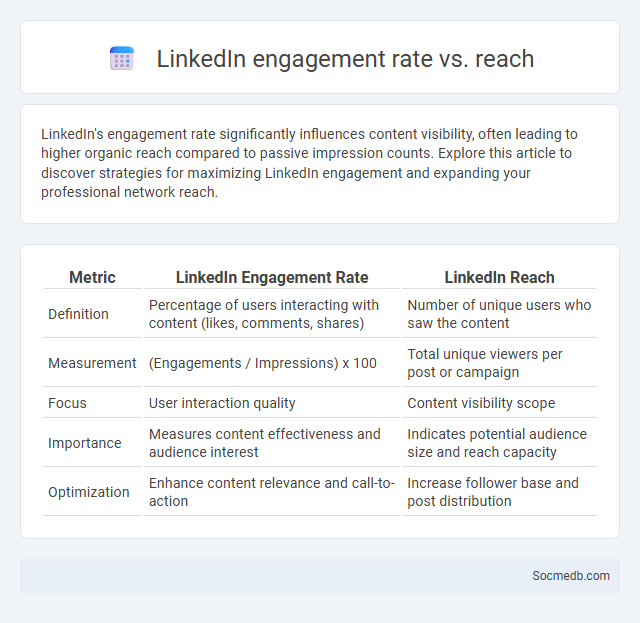
Photo illustration: LinkedIn engagement rate vs reach
LinkedIn's engagement rate significantly influences content visibility, often leading to higher organic reach compared to passive impression counts. Explore this article to discover strategies for maximizing LinkedIn engagement and expanding your professional network reach.
Table of Comparison
| Metric | LinkedIn Engagement Rate | LinkedIn Reach |
|---|---|---|
| Definition | Percentage of users interacting with content (likes, comments, shares) | Number of unique users who saw the content |
| Measurement | (Engagements / Impressions) x 100 | Total unique viewers per post or campaign |
| Focus | User interaction quality | Content visibility scope |
| Importance | Measures content effectiveness and audience interest | Indicates potential audience size and reach capacity |
| Optimization | Enhance content relevance and call-to-action | Increase follower base and post distribution |
Understanding LinkedIn Engagement Rate
LinkedIn engagement rate measures the level of interaction (likes, comments, shares) relative to the total number of followers or impressions on a post. A high engagement rate, typically above 2%, indicates content resonates well with the professional audience, enhancing brand visibility and networking opportunities. Consistently tracking engagement metrics helps refine content strategies to boost reach and foster meaningful connections on LinkedIn.
What is LinkedIn Reach?
LinkedIn Reach refers to the total number of unique users who have seen your content on the platform, reflecting the visibility and exposure your posts achieve. Understanding your LinkedIn Reach helps you measure the effectiveness of your content strategy and the potential impact on your professional network. Maximizing your reach can significantly enhance Your opportunities for networking, brand building, and lead generation.
Content Strategy Defined for LinkedIn
Content strategy for LinkedIn revolves around creating professional and industry-relevant posts that engage target audiences and showcase expertise. Effective LinkedIn content includes thought leadership articles, case studies, and company updates tailored to business professionals and decision-makers. Optimizing post timing, utilizing LinkedIn analytics, and incorporating multimedia elements significantly enhance visibility and engagement on the platform.
Key Differences: Engagement Rate vs Reach
Engagement Rate measures the percentage of your audience that interacts with your content through likes, comments, and shares, reflecting the quality of connections you build. Reach quantifies the total number of unique users who have seen your posts, indicating the breadth of your content's visibility. Understanding the distinction between Engagement Rate and Reach allows you to optimize your social media strategy for both growth and meaningful interactions.
How Engagement Rate Impacts LinkedIn Success
Engagement rate on LinkedIn is a critical metric that directly influences the visibility and reach of posts within the platform's algorithm. Higher engagement, including likes, comments, and shares, signals content relevance and drives greater exposure to professional networks, enhancing brand awareness and lead generation. Optimizing posts for engagement improves LinkedIn success by attracting targeted audiences and fostering meaningful connections essential for B2B marketing and personal branding.
Maximizing Reach through Effective Content
Maximizing reach on social media requires creating engaging, shareable content tailored to specific audience demographics and platform algorithms. Utilizing multimedia elements such as videos, infographics, and interactive polls boosts user interaction and organic visibility. Consistent posting schedules combined with targeted hashtags and analytics-driven strategies further amplify content distribution and follower growth.
Aligning Content Strategy with LinkedIn Algorithms
Optimizing content for LinkedIn requires understanding its algorithm, which prioritizes meaningful interactions and professional relevance. Crafting posts that encourage comments and shares among industry peers enhances visibility within users' networks. Consistent use of relevant keywords and hashtags aligned with target audience interests boosts engagement and algorithmic ranking on LinkedIn.
Measuring and Analyzing LinkedIn Metrics
Measuring and analyzing LinkedIn metrics involves tracking key performance indicators such as engagement rate, click-through rate, and follower growth to evaluate content effectiveness. Advanced analytics tools provide insights into audience demographics, post reach, and referral traffic, enabling data-driven decision-making for optimized LinkedIn strategies. Consistent monitoring of conversion rates and sentiment analysis helps refine targeting and messaging to boost professional network impact.
Best Practices for Boosting Engagement on LinkedIn
Maximize your LinkedIn engagement by consistently posting relevant industry insights and utilizing rich media like videos and infographics to capture attention. Optimize your profile with targeted keywords to improve discoverability and foster meaningful interactions through personalized comments and direct messages. Leverage LinkedIn Analytics to track performance metrics, refine your content strategy, and ensure your posts resonate with your professional audience.
Building a Data-Driven LinkedIn Content Strategy
Building a data-driven LinkedIn content strategy involves analyzing engagement metrics such as click-through rates, likes, comments, and shares to identify high-performing posts. Leveraging LinkedIn Analytics tools enables marketers to track audience demographics and content reach, optimizing publishing times and content formats accordingly. Incorporating keyword research and competitor benchmarking further refines content relevance, driving higher visibility and sustained follower growth.
 socmedb.com
socmedb.com